Junning Cui
Center of Ultra-precision Optoelectronic Instrument engineering, Harbin Institute of Technology, Key Lab of Ultra-precision Intelligent Instrumentation, Harbin Institute of Technology
Geometric Artifact Correction for Symmetric Multi-Linear Trajectory CT: Theory, Method, and Generalization
Aug 27, 2024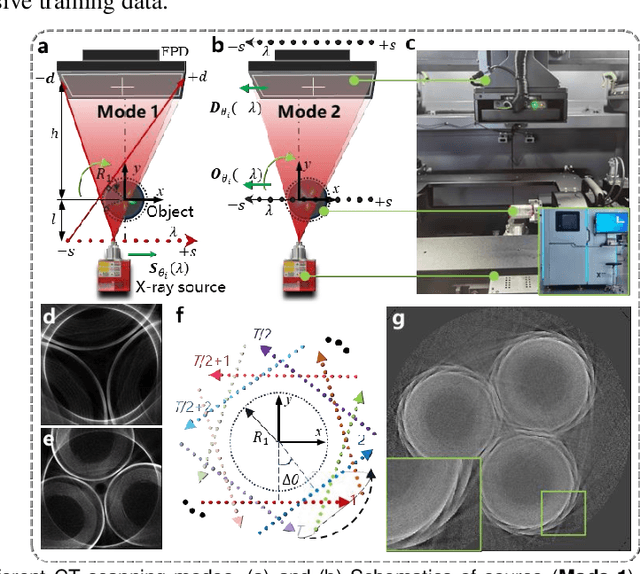

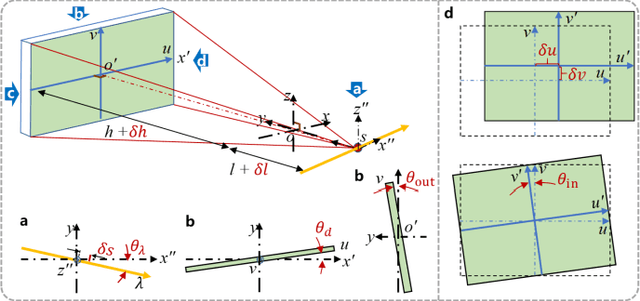
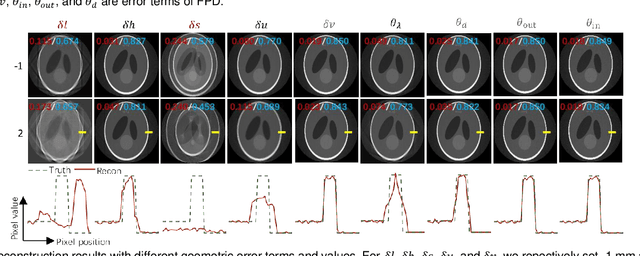
Abstract:For extending CT field-of-view to perform non-destructive testing, the Symmetric Multi-Linear trajectory Computed Tomography (SMLCT) has been developed as a successful example of non-standard CT scanning modes. However, inevitable geometric errors can cause severe artifacts in the reconstructed images. The existing calibration method for SMLCT is both crude and inefficient. It involves reconstructing hundreds of images by exhaustively substituting each potential error, and then manually identifying the images with the fewest geometric artifacts to estimate the final geometric errors for calibration. In this paper, we comprehensively and efficiently address the challenging geometric artifacts in SMLCT, , and the corresponding works mainly involve theory, method, and generalization. In particular, after identifying sensitive parameters and conducting some theory analysis of geometric artifacts, we summarize several key properties between sensitive geometric parameters and artifact characteristics. Then, we further construct mathematical relationships that relate sensitive geometric errors to the pixel offsets of reconstruction images with artifact characteristics. To accurately extract pixel bias, we innovatively adapt the Generalized Cross-Correlation with Phase Transform (GCC-PHAT) algorithm, commonly used in sound processing, for our image registration task for each paired symmetric LCT. This adaptation leads to the design of a highly efficient rigid translation registration method. Simulation and physical experiments have validated the excellent performance of this work. Additionally, our results demonstrate significant generalization to common rotated CT and a variant of SMLCT.
OSNet & MNetO: Two Types of General Reconstruction Architectures for Linear Computed Tomography in Multi-Scenarios
Sep 25, 2023
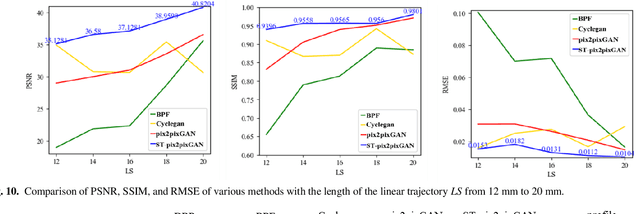
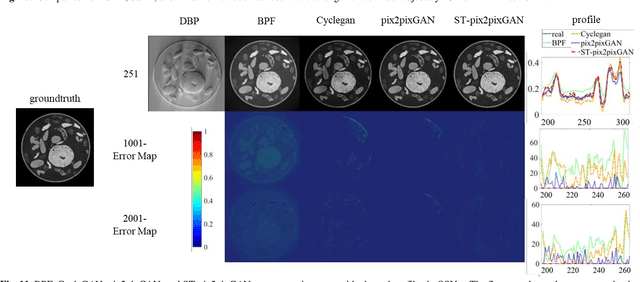

Abstract:Recently, linear computed tomography (LCT) systems have actively attracted attention. To weaken projection truncation and image the region of interest (ROI) for LCT, the backprojection filtration (BPF) algorithm is an effective solution. However, in BPF for LCT, it is difficult to achieve stable interior reconstruction, and for differentiated backprojection (DBP) images of LCT, multiple rotation-finite inversion of Hilbert transform (Hilbert filtering)-inverse rotation operations will blur the image. To satisfy multiple reconstruction scenarios for LCT, including interior ROI, complete object, and exterior region beyond field-of-view (FOV), and avoid the rotation operations of Hilbert filtering, we propose two types of reconstruction architectures. The first overlays multiple DBP images to obtain a complete DBP image, then uses a network to learn the overlying Hilbert filtering function, referred to as the Overlay-Single Network (OSNet). The second uses multiple networks to train different directional Hilbert filtering models for DBP images of multiple linear scannings, respectively, and then overlays the reconstructed results, i.e., Multiple Networks Overlaying (MNetO). In two architectures, we introduce a Swin Transformer (ST) block to the generator of pix2pixGAN to extract both local and global features from DBP images at the same time. We investigate two architectures from different networks, FOV sizes, pixel sizes, number of projections, geometric magnification, and processing time. Experimental results show that two architectures can both recover images. OSNet outperforms BPF in various scenarios. For the different networks, ST-pix2pixGAN is superior to pix2pixGAN and CycleGAN. MNetO exhibits a few artifacts due to the differences among the multiple models, but any one of its models is suitable for imaging the exterior edge in a certain direction.
Analytical reconstructions of multiple source-translation computed tomography with extended field of views: a research study
May 31, 2023Abstract:This paper is to investigate the high-quality analytical reconstructions of multiple source-translation computed tomography (mSTCT) under an extended field of view (FOV). Under the larger FOVs, the previously proposed backprojection filtration (BPF) algorithms for mSTCT, including D-BPF and S-BPF, make some intolerable errors in the image edges due to an unstable backprojection weighting factor and the half-scan mode, which deviates from the intention of mSTCT imaging. In this paper, to achieve reconstruction with as little error as possible under the extremely extended FOV, we propose two strategies, including deriving a no-weighting D-BPF (NWD-BPF) for mSTCT and introducing BPFs into a special full-scan mSTCT (F-mSTCT) to balance errors, i.e., abbreviated as FD-BPF and FS-BPF. For the first strategy, we eliminate this unstable backprojection weighting factor by introducing a special variable relationship in D-BPF. For the second strategy, we combine the F-mSTCT geometry with BPFs to study the performance and derive a suitable redundant weighting function for F-mSTCT. The experiments demonstrate our proposed methods for these strategies. Among them, NWD-BPF can weaken the instability at the image edges but blur the details, and FS-BPF can get high-quality stable images under the extremely extended FOV imaging a large object but requires more projections than FD-BPF. For different practical requirements in extending FOV imaging, we give suggestions on algorithm selection.
BPF Algorithms for Multiple Source-Translation Computed Tomography Reconstruction
May 30, 2023



Abstract:Micro-computed tomography (micro-CT) is a widely used state-of-the-art instrument employed to study the morphological structures of objects in various fields. Object-rotation is a classical scanning mode in micro-CT allowing data acquisition from different angles; however, its field-of-view (FOV) is primarily constrained by the size of the detector when aiming for high spatial resolution imaging. Recently, we introduced a novel scanning mode called multiple source translation CT (mSTCT), which effectively enlarges the FOV of the micro-CT system. Furthermore, we developed a virtual projection-based filtered backprojection (V-FBP) algorithm to address truncated projection, albeit with a trade-off in acquisition efficiency (high resolution reconstruction typically requires thousands of source samplings). In this paper, we present a new algorithm for mSTCT reconstruction, backprojection-filtration (BPF), which enables reconstructions of high-resolution images with a low source sampling ratio. Additionally, we found that implementing derivatives in BPF along different directions (source and detector) yields two distinct BPF algorithms (S-BPF and D-BPF), each with its own reconstruction performance characteristics. Through simulated and real experiments conducted in this paper, we demonstrate that achieving same high-resolution reconstructions, D-BPF can reduce source sampling by 75% compared with V-FBP. S-BPF shares similar characteristics with V-FBP, where the spatial resolution is primarily influenced by the source sampling.
 Add to Chrome
Add to Chrome Add to Firefox
Add to Firefox Add to Edge
Add to Edge